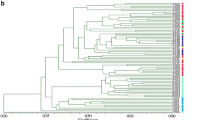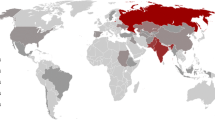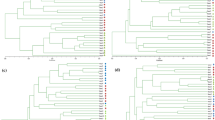Abstract
Accuracy and reproducibility of genetic distances (GDs) based on molecular markers are crucial issues for identification of essentially derived varieties (EDVs). Our objectives were to investigate (1) the amount of variation for amplified fragment length polymorphism (AFLP) markers found among different accessions within maize inbreds and doubled haploid (DH) lines, (2) the proportion attributable to genetic and technical components and marker system specific sources, (3) its effect on GDs between maize lines and implications for identification of EDVs, and (4) the comparison to published SSR data from the same plant materials. Two to five accessions from nine inbred lines and five DH lines were taken from different sources of maintenance breeding or drawn as independent samples from the same seed lot. Each of the 41 accessions was genotyped with 20 AFLP primer combinations revealing 988 AFLP markers. Map positions were available for 605 AFLPs covering all maize chromosomes. On average, six (0.6%) AFLP bands were polymorphic between different accessions of the same line. GDs between two accessions of the same line averaged 0.013 for inbreds and 0.006 for DH lines. The correlation of GDs based on AFLPs and SSRs was tight (r = 0.97**) across all 946 pairs of accessions but decreased (r = 0.55**) for 43 pairs of accessions originating from the same line. On the basis of our results, we recommend specific EDV thresholds for marker systems with different degree of polymorphism. In addition, precautions should be taken to warrant a high level of homogeneity for DNA markers within maize lines before applying for plant variety protection.
Similar content being viewed by others
References
Anscombe F.J. and Tukey J.W. 1963. The examination and analysis of residuals. Technometrics 5: 141–160.
ASSINSEL 2000. DUS testing: Phenotype vs. Genotype. ASSINSEL, Position Paper adopted at the Rome Congress in May 2000.
Bagley M.J., Anderson S.L. and May B. 2001. Choice of methodology for assessing genetic impacts of environmental stressors: polymorphism and reproducibility of RAPD and AFLP fingerprints. Ecotoxicology 10: 239–244.
Bar-Hen A. and Charcosset A. 1994. Relationship between molecular and morphological distances in a maize inbred lines collection. Application for breeder's rights protection. Biometrics in Plant Breeding: Applications of Molecular Markers. In: Proceedings of the Ninth Meeting of the EUCARPIA section Biometrics in Plant Breeding. pp. 57–66.
Dice L.R. 1945. Measures of the amount of ecologic association between species. Ecology 26: 297–302.
Dillmann C., Bar-Hen A., Guerin D., Charcosset A. and Murigneux A. 1997. Comparison of RFLP and morphological distances between maize (Zea mays L.) inbred lines - consequences for germplasm protection purposes. Theor. Appl. Genet. 95: 92–102.
Drake J.W., Charlesworth B., Charlesworth D. and Crow J.F. 1998. Rates of spontaneous mutation. Genetics 148: 1667–1686.
Efron B. 1979. Bootstrap methods: another look at the jackknife. Ann. Stat. 7: 1–26.
Hansen M., Kraft T., Christiansson M. and Nilsson N.O. 1999. Evaluation of AFLP in Beta. Theor. Appl. Genet. 98: 845–852.
Hatcher S.L., Lambert Q.T., Raymond L.T. and Carlson J.R. 1993. Heteroduplex formation: a potential source of errors from PCR products. Prenatal Diagnosis 13: 171–177.
Heckenberger M., Bohn M., Ziegle J.S., Joe L.K., Hauser J.D., Hutton M. et al. 2002. Variation of DNA fingerprints among accessions within maize inbred lines and implications for identification of essentially derived varieties. I. Genetic and technical sources of variation in SSR data. Mol. Breed. 10: 181–191.
Jaccard P. 1908. Nouvelles recherches sur la distribution florale. Bull. Soc. Vaud. Sci. Nat. 44: 223–270.
Johnson N.L., Kotz S. and Kemp A.W. 1992. Univariate Discrete Distributions. J. Wiley and Sons, Inc., New York.
Jones C.J., Edwards K.J., Castaglione S., Winfield M.O., Sala F., Vandewiel C. et al. 1997. Reproducibility testing of RAPD, AFLP and SSR markers in plants by a network of European laboratories. Mol. Breed. 3: 381–390.
Knaak C., Förster J. and Jäger-Gussen M. 1996. 'Abgeleitete’ Sorten aus praktischer Sicht. Bericht über die 47. Arbeitstagung 1996 der Saatzuchtleiter im Rahmen der ‘Vereinigung österreichischer Pflanzenzüchter’ BAL Gumpenstein. pp. 167–172.
Link W., Dixkens C., Singh M., Schwall M. and Melchinger A.E. 1995. Genetic diversity in European and mediterranean faba bean germ plasm revealed by RAPD markers. Theor. Appl. Genet. 90: 27–32.
Lübberstedt T., Melchinger A.E., Dussle C., Vuylsteke M. and Kuiper M. 2000. Relationships among early European maize inbreds: IV. Genetic diversity revealed with AFLP markers and comparison with RFLP, RAPD, and pedigree data. Crop. Sci. 40: 783–791.
Lübberstedt T., Vuylsteke M., Dussle C., Kuiper M. and Melchinger A.E. 1999. Untersuchungen zur genetischen Diversität zwischen europäischen Maisinzuchtlinien mit AFLPs, RFLPs, RAPDs, und SSRs - ein Vergleich verschiedener Markersysteme. Bericht über die 49. Arbeitstagung 1998 der Vereinigung österreichischer Pflanzenzüchter, BAL Gumpenstein. pp. 45–49.
Mantel N.A. 1967. The detection of disease clustering and a generalized regression approach. Cancer Res. 27: 209–220.
Melchinger A.E. 1999. Genetic Diversity and Heterosis. In: Coors J.G. and Pandery S. (eds), The Genetics and Exploitation of Heterosis in Crops. Crop Science Society of America, Inc., Madison, USA, pp. 99–118.
Murigneux A., Barloy D., Leroy P. and Beckert M. 1993. Molecular and morphological evaluation of doubled haploid lines in maize. 1. Homogeneity within DH lines. Theor. Appl. Genet. 86: 837–842.
Nataraj A.J., Olivos-Glander I., Kusukawa N. and Highsmith W.E. 1999. Single-strand conformation polymorphism and heteroduplex analysis for gel-based mutation detection. Electrophoresis 20: 1177–1185.
Nei M., Tajima F. and Tateno Y. 1983. Accuracy of estimated phylogenetic trees from molecular data. II. Gene frequency data. J. Mol. Evol. 19: 153–170.
Peleman J., van Wijk R., van Oeveren J. and van Schaik R. 2000. Linkage map integration: an integrated genetic map of Zea mays L. Poster P472. Plant & Animal Genome Conference VIII.
Powell W., Morgante M., Andre C., Hanafey M., Vogel J., Tingey S. et al. 1996. The comparison of RFLP, RAPD, AFLP and SSR (microsatellite) markers for germplasm analysis. Mol. Breed. 2: 225–238.
Rohlf F.J. 1989. NTSYS-pc Numerical Taxonomy and Multivariate Analysis System. Exeter Publishing Co, Ltd., Setauket, NY, USA.
Roldan-Ruiz I., Calsyn E., Gilliland T.J., Coll R., van Eijk M.J.T. and De Loose M. 2000. Estimating genetic conformity between related ryegrass (Lolium) varieties. 2. AFLP characterization. Mol. Breed. 6: 593–602.
SAS Institute 1988. SAS/STAT User's guide, Release 6.03 edn. SAS, Cary.
Smith J.S.C., Smith O.S., Bowen S.L., Tenborg R.A. and Wall S.J. 1991. The description and assessment of distances between inbred lines of maize. III. A revised scheme for the testing of distinctiveness between inbred lines utilizing DNA RFLPs. Maydica 36: 213–226.
Vos P., Hogers R., Bleeker M., Reijans M., Lee T.v.de., Hornes M. et al. 1995. AFLP: a new technique for DNA fingerprinting. Nucleic Acids Res. 23: 4407–4414.
Yap I.V., Nelson R.J. and WinBoot 1996. A program for performing bootstrap analysis of binary data to determine confidence limits of UPGMA-based dendrograms. International Rice Research Institute, Manila, Philippines.
Author information
Authors and Affiliations
Rights and permissions
About this article
Cite this article
Heckenberger, M., van der Voort, J.R., Peleman, J. et al. Variation of DNA fingerprints among accessions within maize inbred lines and implications for identification of essentially derived varieties: II. Genetic and technical sources of variation in AFLP data and comparison with SSR data. Molecular Breeding 12, 97–106 (2003). https://doi.org/10.1023/A:1026040007166
Issue Date:
DOI: https://doi.org/10.1023/A:1026040007166




